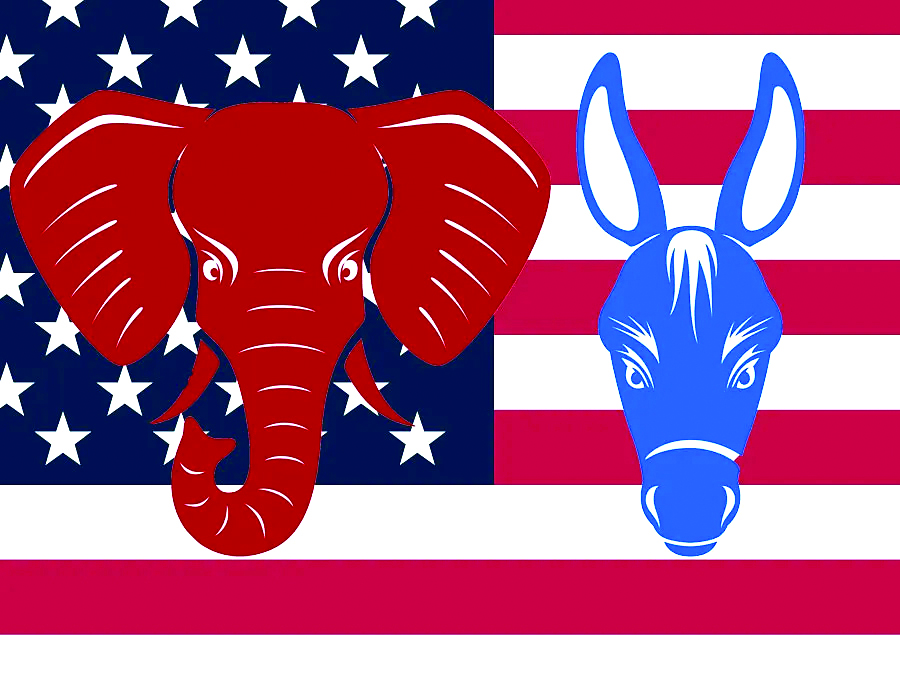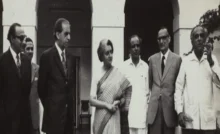The competition between the Democratic and Republican parties is a fundamental aspect of democracy in the United States of America, reflecting diverse viewpoints and values among the electorate while shaping the country’s policy direction and governance.
The Democratic and Republican parties are the two major political parties in the United States of America, each with a long and evolving history. Both parties have evolved significantly over time, responding to changing social, economic, and political landscapes. They compete vigorously in elections at all levels of government and often represent differing views on issues such as healthcare, immigration, foreign policy, and the role of government in society.
The Republican Party, also referred to as the GOP (“Grand Old Party”), is one of the two major contemporary political parties in the United States, along with its main historic rival, the Democratic Party. The GOP was founded in 1854 by opponents of the Kansas–Nebraska Act, which allowed for the potential expansion of chattel slavery into the western territories. The party supported economic reform and classical liberalism while opposing the expansion of slavery
Here’s a brief overview:
Democratic Party History
The Democratic Party traces its origins back to the Democratic-Republican Party founded by Thomas Jefferson and James Madison in the 1790s. It emerged as a major political force in the 1820s under President Andrew Jackson, advocating for states’ rights, limited government, and policies favoring farmers and the working class.
Throughout the 19th century, the Democratic Party was often associated with agrarian interests, southern states, and opposition to a strong federal government.
It split over issues such as slavery in the 1860s, leading to the formation of the Southern Democrats who supported segregation and states’ rights.
The Democratic Party evolved significantly with the New Deal coalition under President Franklin D. Roosevelt in the 1930s, which expanded the party’s base to include labor unions, urban workers, and minorities.
It became associated with progressive policies such as social welfare programs, civil rights, and environmental protection.
In recent decades, the Democratic Party has continued to support progressive social policies, healthcare reform, environmental protection, and government intervention in the economy.
Republican Party
The Republican Party was founded in 1854 in opposition to the expansion of slavery into new U.S. territories. It quickly became the dominant political force in the North during the Civil War era, advocating for abolitionism, economic modernization, and a strong federal government.
After the Civil War, the Republican Party supported Reconstruction policies to integrate freed slaves into society and protect their rights.
It was associated with industrial interests, economic conservatism, and a vision of a strong federal government promoting economic development.
In the early 20th century, the Republican Party continued to advocate for business interests, fiscal conservatism, and limited government intervention.
It became associated with movements like Progressivism under Theodore Roosevelt and later with economic policies favoring deregulation and tax cuts.
In recent decades, the Republican Party has emphasized conservative values such as limited government, individual liberty, free market economics, and a strong national defense.
It has attracted support from social conservatives, evangelical Christians, and advocates of lower taxes and reduced government spending.
Contemporary Landscape
Both parties have evolved significantly over time, responding to changing social, economic, and political landscapes. They compete vigorously in elections at all levels of government and often represent differing views on issues such as healthcare, immigration, foreign policy, and the role of government in society.
Understanding the histories and ideologies of the Democratic and Republican Parties helps to contextualize their current positions on various issues and their strategies in contemporary politics.
Competition
The competition between the Democratic and Republican parties in the United States is central to American politics and democracy. Here are some key aspects of their competition:
Electoral Competition
Elections: Both parties compete in local, state, and national elections, including presidential, congressional, gubernatorial, and local elections.
Voter Base: Each party has a distinct voter base. Democrats often appeal to urban residents, minorities, young people, and educated professionals. Republicans typically attract rural voters, older demographics, evangelical Christians, and business interests.
Campaign Strategies: Both parties employ sophisticated campaign strategies including advertising, grassroots organizing, fundraising, and media outreach to mobilize voters and win elections.
Ideological Competition
Policy Positions: Democrats generally support progressive policies such as healthcare reform, environmental protection, social welfare programs, and civil rights. Republicans typically advocate for conservative principles such as limited government, lower taxes, deregulation, and traditional values.
Political Rhetoric: Each party uses rhetoric to differentiate itself and criticize the other. Democrats often emphasize social justice, equality, and government intervention to address societal issues. Republicans often stress individual freedom, personal responsibility, and the importance of free markets.
Legislative Competition
Legislative Agenda: In Congress and state legislatures, Democrats and Republicans propose competing legislation and negotiate to advance their respective policy agendas. Partisan Gridlock: Political polarization can lead to gridlock, where each party’s priorities are often at odds, making bipartisan cooperation challenging.
Influence and Power
Control of Government: Both parties vie for control of the executive branch (presidency and governors), legislative branch (Congress and state legislatures), and judicial branch (appointing judges). Control allows each party to implement its policies and influence governance.
Public Opinion: Competing for public support and approval is crucial for each party’s electoral success. They use polling, focus groups, and public messaging to shape public opinion and sway voters.
Challenges and Dynamics
Changing Demographics: Shifting demographics, such as increasing diversity and generational changes, influence each party’s electoral strategy and coalition-building efforts.
Media and Communication: The role of media and social media in shaping public perception and political discourse has become increasingly significant, affecting how parties communicate their messages and engage with voters.
The competition between the Democratic and Republican parties is a fundamental aspect of American democracy, reflecting diverse viewpoints and values among the electorate while shaping the country’s policy direction and governance.
Major Leaders
Here are some major leaders from both the Democratic and Republican parties throughout history, spanning various levels of government and influence:
Democratic Party Leaders
Franklin D. Roosevelt: President from 1933 to 1945, known for the New Deal and leading the United States through much of World War II.
John F. Kennedy: President from 1961 to 1963, remembered for his advocacy of civil rights, space exploration, and economic reform.
Bill Clinton: President from 1993 to 2001, focused on economic prosperity, welfare reform, and healthcare policy.
Barack Obama: President from 2009 to 2017, known for healthcare reform (Affordable Care Act), economic recovery efforts, and foreign policy initiatives.
Joe Biden: President since 2021, previously Vice President under Obama, known for his legislative career and focus on healthcare, infrastructure, and climate change.
Nancy Pelosi: Long-serving Democratic Congresswoman from California, Speaker of the House since 2019, a prominent figure in advancing Democratic legislative priorities.
Harry S. Truman: President from 1945 to 1953, known for his leadership during the end of World War II and the early Cold War period.
Republican Party Leaders
Abraham Lincoln: President from 1861 to 1865, led the United States through the Civil War, emancipated slaves with the Emancipation Proclamation, and promoted national unity.
Theodore Roosevelt: President from 1901 to 1909, known for progressive reforms, conservation efforts, and asserting U.S. influence internationally.
Ronald Reagan: President from 1981 to 1989, advocated for conservative economic policies (Reaganomics), reduced government regulation, and a strong stance against communism.
Richard Nixon: President from 1969 to 1974, known for opening relations with China, ending U.S. involvement in Vietnam, and later resigning due to the Watergate scandal.
George H.W. Bush: President from 1989 to 1993, focused on foreign policy successes like the end of the Cold War and the Gulf War.
Donald Trump: President from 2017 to 2021, known for his outsider status, controversial policies on immigration and trade, and emphasis on deregulation and tax cuts.
Mitch McConnell: Long-serving Republican Senator from Kentucky, Senate Minority Leader (2007-2015) and Senate Majority Leader (2015-2021), known for his strategic leadership and legislative influence.
These leaders have shaped their parties’ ideologies, policies, and legacies, leaving significant impacts on American politics and history. Their actions and decisions have often defined their respective eras and continue to influence political discourse today.









![[L-R] WW1 Victoria Cross recipient Khudadad Khan, Rifleman Gabar Singh Negi and Lance-Daffadar Gobind Singh.](https://link4din.com/guardians-numeric-wisdom/wp-content/uploads/2025/02/Untitled-design-4-220x134.webp)